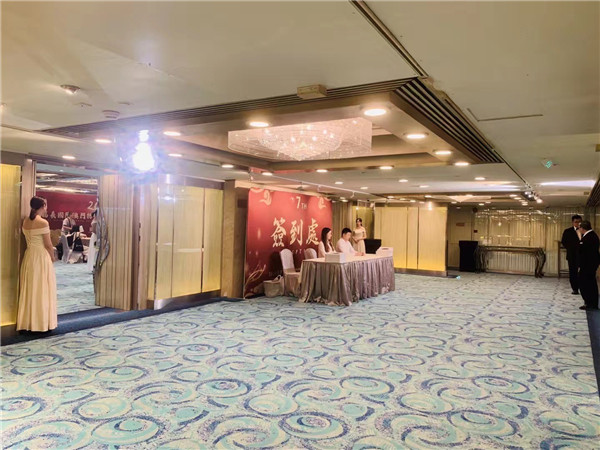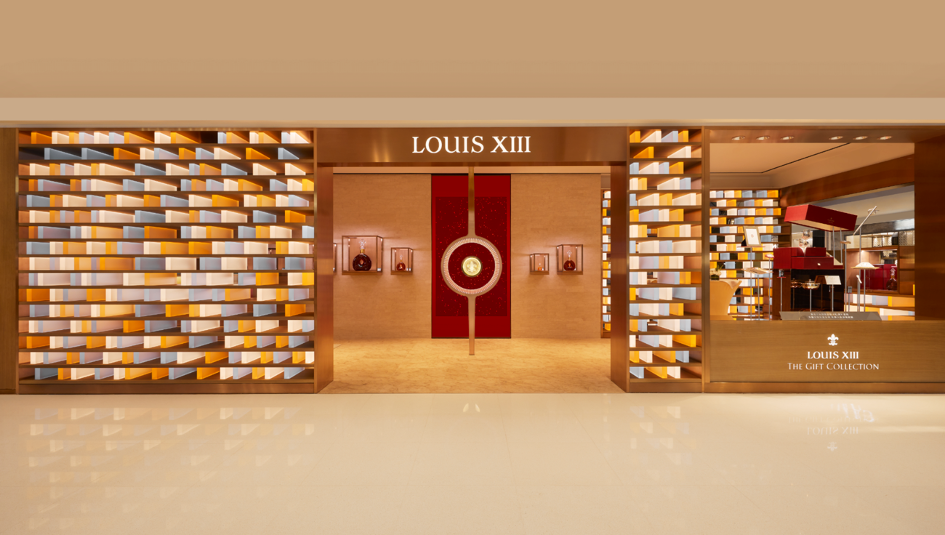刘恒甫的多维艺术世界
“城市公共艺术家”刘恒甫
从小出生在美丽的冰雪之城
他用绘画写生着世界万物
用镜头记录着冰与雪的世界
用雕塑装点城市文化
用设计连接未来
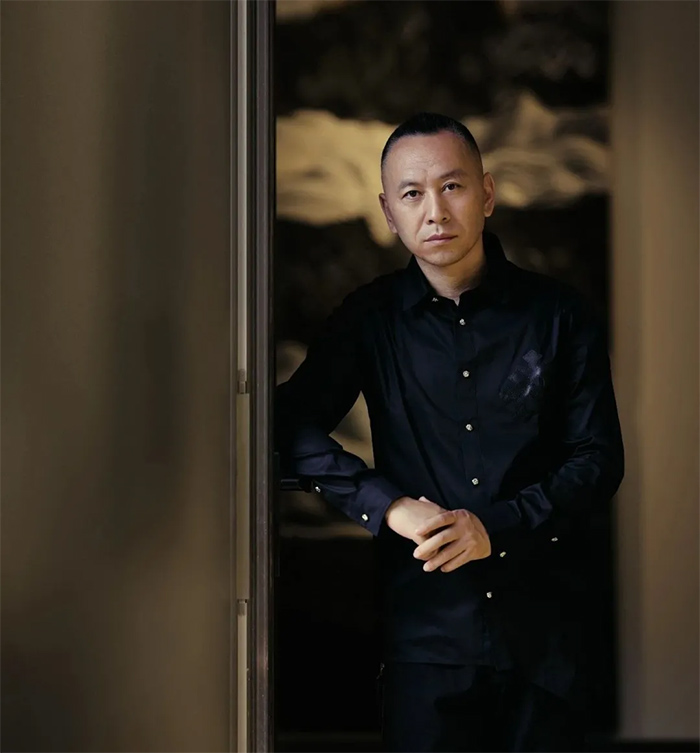
刘恒甫-城市公共艺术家
中国开发性金融促进会文旅委员会副主任、创意总监
中国艺术研究院名誉研究员
故宫研究院客座研究员
清华设计院文化旅游学院艺术总监
北京市优秀文化艺术人才
北京恒甫视界艺术总监
曾荣获中国工艺美术大师金奖、中国旅游商品博览会金奖首届中国创意设计大赛金奖、2015年中国最佳主题公园奖
他曾经为了记录冰花绽放的瞬间
疯狂让人用雪球砸他
才捕捉下这唯美的一景
摄影-雪花清韵

摄影-窗花梦幻
摄影-冰彩神奇
拥有逾500台相机,既是收藏品,也是创作工具。
摄影塑造了他个人的冰雪美学。
此外,他还绘画、做雕塑、
建造了公益展馆、设计了主题公园、
拥有自己的时尚品牌等,
并且多年来乐此不疲,
成为一个多维艺术家。
公共艺术-艺创嘉华
十月底
我们拜访了刘恒甫老师的艺术馆,
和他一起喝茶、聊天
探讨“他的关于艺术那些事儿”。

刘恒甫北京工作室
刘恒甫老师的工作室坐落在北京宋庄,工作室紧依一个青翠宁静的湖,湖边矗立着一尊巨大的有如中国剪纸造型的红色鱼形艺术装置,非常引人注目。

《中华有鱼》国家南海博物馆,长12米

刘恒甫:现在这个作品就是我的一个代表作叫《中华有鱼》,这件作品它是用一个祥云彩蝶中国结,用中国的红颜色表现中国的一种吉祥,一种幸福,它是用什么呢,用手工做出工业标准,就相当于用手工去制造个汽车一样,纯手工做的,这条鱼也是用了我代表性的创作语言。

雕塑《春风》
刘恒甫:这件作品的名字叫《春风》,它是用这个面和重复的线条构成的空间体量,你看它在人在动的时候,随着各种角度的变化,它在产生各种细微的切换。
秦红:每一个角度的画面都不同。
工作室内展示了他各时期的作品
刘恒甫:这个展示空间展示着我不同时期的创作作品,上面阶段是“心象无极"系列,这边是“禅”的系列,包括刚才看的雕塑。
油画-环宇冰心(2010)
莲?心,120x360cm,不锈钢圆雕,2014
秦红:您出生在美丽的北方冰城,这对于您用这种千姿百态晶莹剔透的冰花作为艺术元素进行创作,有什么直接的影响?
刘恒甫:当然有影响,而且影响非常深远。因为北方作为一个寒冷洪荒、浩淼这么一个自然的世界,它不仅塑造了人的性格,同时这种自然的生态它也给人千万联想和遐想,这样就产生了冰雪的晶莹和剔透、林海雪原这种洪荒苍茫。
布面油画-春山雪霁
纵观我的艺术创作,还是这种叫质朴雄浑、简约博大,关键就是在解读和表现宇宙、山川、自然、大的这种广阔的意境和境界,这就是山水、天地、人文之间的关系。
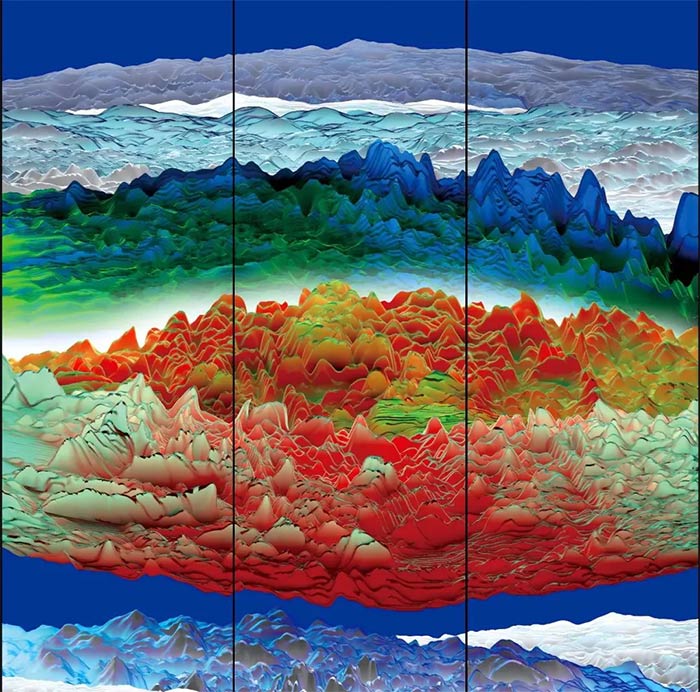
江山圣境,240x240cm,布面油画,2010
其实我的整个艺术创作呢有几个阶段的跨越,第一个阶段应该叫看山是山,看水是水。这个阶段是属于学习阶段,属于艺术在入门,在前期积累学习的阶段,这个期间对自然、万物、包括各种题材的理解,表现和表象,它是基于对自然原生态的一种苗头。
心象无极,80x240cm,布面油画,2007
第二个阶段就是说看山不是山,看水不是水,就是讲主观的内容了。比如说我看到山川,我看到林海,我想到的是生命的燃烧、是一个伟大的图腾。这时候达到一个艺术创生、创造的这么一个境界,就是强调主观表现,最高的境界就是看山还是山,看水还是水,这个是最难的。就把一切表现浮躁的浮夸的东西,把它洗掉,一切直达主题。
丝路祥音,150x340cm,布面油画,2015
为什么我朋友讲你的绘画,有大师味道,就是不用去想那么多,这种就是尼采讲叫什么呢、叫人生三个境界不也是吗?
最后归属于婴儿这种天真、浪漫、无我、自然的状态,这是在咱们中国来讲就叫天人合一。
布面油画-心象无极(2009)
秦红:您的艺术创作涉及了绘画、摄影、雕塑、平面设计、城市的景观设计、建造很多的方面,您是一位名副其实的跨界艺术家,那么您是怎样理解多维艺术家这个概念?
刘恒甫:其实多维很简单,世界是多维的,人生多维的。还有一个是什么?上帝给咱们装这套硬件感知系统多维的,分听觉、视觉、味觉、触觉,所以说这样的话就是人本身就很立体,从艺术创作上我认为也很简单,你想做啥做啥,要想做二维的,我就把二维叫做图形,三维叫做立体造型,当然还有四维,别局限于什么一个画种,一个画派一个雕塑的手段,千万别受这些羁绊,不要受这些拘泥和这些形式的拘泥。所以说不能受各所谓的专业的拘泥,想干啥干啥。
木雕-梅兰竹菊(2016)
秦红:这中间有一个从二维平面到多维立体的思维转化,您是怎样完成转化过程的?
刘恒甫:一是随意行走,二我是来自基层,我所要做的事我要完成目的,我要用各种手段来表现,这就不拘泥这种技巧技法,该用的笔的笔,该用刀的刀,该直接领着人,拉一堆电焊机可以直接焊了是吧?
公共艺术-金风浩荡
我的有些作品很大,我曾经做过一条50米长的鱼,每一个构件都用吊车的。
秦红:50米长的鱼,难以想象。
秦红:现在在哪里放着?
刘恒甫:在松花江边。
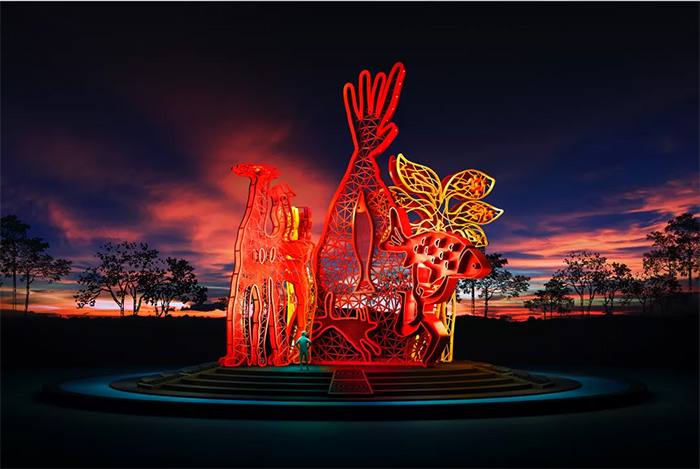
公共艺术-冰源圣景
秦红:您用雕塑、绘画与设计等多种介质诠释着东方的文化精神,那么您认为传统的文化艺术在未来是一个怎样的发展态势?
刘恒甫:我们一直在说的一个观点叫民族的是世界的,错,我在认为民族的永远是民族的,世界的它才是世界的。作为当今整个世界的文化思潮,包括审美风尚,它是有一个时代特色的,首先要用人性化的语言,鲜明的符号来感动所有的人,这种才是最高级的作品。不要刻意的强调民族时代技巧。
这些都是手段,最重要的是表达出想表达的内容,表达什么很重要。
雕塑-绿水青山 千里江山
作为艺术,虽然没有民族,但是有东西方。东西方上到最高层是哲学和宗教,它们之间产生差异,所以说这个时代,无论是中国的画家、艺术家,或者东方的艺术家想赢得全世界的掌声或者尊重的话,他要用国际化的语言,国际化的手法,最后表现东方的文化精神。
说到精神它是个实质东西,精神是什么?东方化精神的是老子庄子一种神秘形之上的悠远意境。

油画-《元》系列(2015)
秦红:正想问您,您作品中的这种东方意蕴要表达的是不是就是您说的这些。
刘恒甫:东方意蕴、东方情韵、东方的这种哲学,甚至说宗教的最高境界,这个不仅是从绘画上,从任何艺术门类最高境界都是叫禅心、文心、菩提心,达到这个境界。无论是绘画、雕塑、音乐、舞蹈、书法,所有的最高的境界都是达到什么呢?像刚才咱讲的叫最高境界叫不食人间烟火气,那种空明、寂静、悠远,这是咱们东方文化的最高境界,就是禅境。
秦红:那么想问一下哪一幅作品是您自己最满意的代表作,比如说是不是我们身后的这幅《心象无极》。
心象无极No.003,109x327cm,布面油画,2007
刘恒甫:这幅作品它把山川、宇宙、心象、神灵汇集到一个画面上,你看它不是山,但是有山的巍峨;它不是海,但是有海的广博,一束金光从天外打来,金光普照天地吉祥。

这幅作品也是代表我的东西方绘画融合的一个最高境界。因为刚才讲到,东西方它不是靠地理来界定,因为地球是圆的,谁承认谁东谁西,但是从宗教上叫耶稣,他管它叫西方,像释迦摩尼、穆罕默德,信这个宗教叫东方。
这件作品是从神学层面跨了东西方,全世界不同民族、不同信仰、不同国界的人都能找到自身的信仰,从文化的层面,从哲学的层面真正跨越了东西方。
秦红:您的冰雪系列的艺术作品,今年刚刚在故宫展出,您是怎样看待艺术与冬奥以及体育的结合?

揭幕嘉宾:叶乔波、王旭东、刘静民、刘恒甫、韩子荣、赵少华、张建星(左起)
刘恒甫:体育文化都是生活的部分,它们应该先天的就是一个不可分割的结合。你比如包括古希腊一些竞技,包括现在的体操,它都是人运动至美的形态一个表现,所以它本身就是艺术。
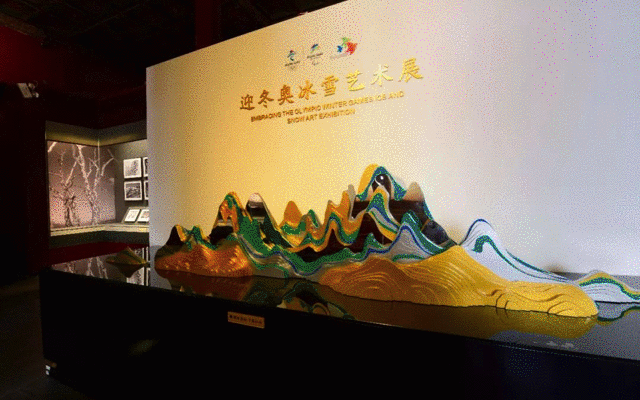
所以冰雪和冬奥,它俩又是一个不可分的关系。因为冬奥两个字儿,一个是冬,一个是奥,奥就是奥林匹克,冬代表季节。当然也就区分了咱们体育竞技项目的种类,所以说我们北京虽然是自然冰雪,差强人意,但是我们如果有最高层次世界最顶级的冰雪艺术来点缀衬托,这个时候一样能赢得全世界的喝彩。所以说我认为一个冰雪艺术至少在北京冬奥能为国争光,为冬奥添彩。
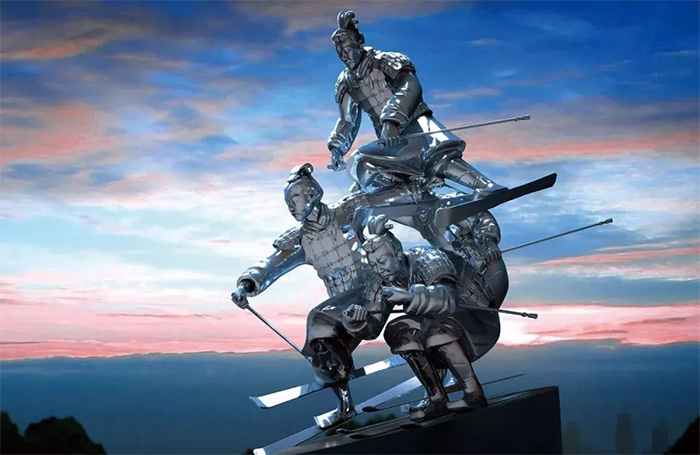
《中华之梦》北京冬奥主题雕塑,高12米
国际奥委会主席|托马斯?巴赫
为艺术家刘恒甫展览致序
“迎冬奥冰雪艺术展”
北京是一座历史悠久之城,也是一座创造历史之城。作为2022年冬奥会的主办城市,北京将再次创造历史,成为世界上首座既举办夏季奥运会又举办冬季奥运会的城市。北京2022年冬奥会将首次在中国展现奥运冰雪运动的神奇魅力。
本画册收录了迎冬奥冰雪艺术展的精彩图集,邀请读者透过中国艺术表现的镜头发现冬季运动的魅力。此画册是奥林匹克主义始终与运动和文化相互交融的美丽例证,也是国际奥委会创始人与奥运会复兴者顾拜旦的基本理念。
作为中国首次在标志性的故宫博物院举办的此类展览,是宣传北京2022年冬奥会和鼓励公众参与冬季运动的重要一步。这也是我希望向本次展览的组织方——北京冬奥组委、北京奥运城市发展促进会和故宫博物院表示祝贺的原因。
北京2022年冬奥会所体现的冬季运动魅力和奥林匹克价值观将激励新一代人。北京将在2022年迎接全球最优秀的运动员,再次创造奥运历史,而本次展览这样的文化亮点为此奠定了基础。
托马斯·巴赫
国际奥委会主席
秦红:作为著名的冰雪艺术家,您是怎样一直保持着自己的创作激情?灵感都来自哪里?
刘恒甫:我的灵感首先还是对自然的热爱,因为人嘛,我对山川、对自然的万物,那种崇尚那种至美这种追求,有句话叫知之者不如好之者,好之者不如乐之者,我很荣幸我是乐之者,所以说我对自然的亲近,对艺术的追求是我的快乐。
秦红:恒甫老师有一个surprise给您,因为今天要对您做采访,昨天晚上我给您画了一张肖像。
刘恒甫:太精彩了,大师风范,神似。
秦红:后面的这个图像是您的一个景观设计,在哪里呢?
刘恒甫:是有一个景观雕塑,这个是26米高,在八达岭高速在这矗立,应该说咱们目前中国迎冬奥最大一件作品。
《托起明天》北京冬奥主题雕塑,高26米
刘恒甫:谢谢秦红老师,这画画的太精彩了,神似,特别喜欢。
秦红:我觉得这一次我也是有幸的去欣赏参观了恒甫老师在故宫的画展,希望不久的将来可以在凡尔赛宫或者是卢浮宫看到您新的展览。
刘恒甫:好 ,谢谢。
责编:Echo
Transboundary Unbounded
Liu Hengfu’s Multidimensional Art World
Sophie Qin:Today we have come to visit teacher Liu Hengfuchr(39)s studio. Let’s enter his world of art.
Liu Heng Fu:Mrs.Qin Hong
Sophie Qin:Hello, Teacher Heng Fu,Teacher HengNi.
Liu Heng Fu:Come in, come in, welcome, warm welcome!
Sophie Qin:Thank you.
Teacher HengNi:I will prepare some tea for you.
Sophie Qin:Thank you.
Spring Breeze
Liu Heng Fu:The name of this work isSpringBreeze.It has depth of volume formed by this surface and repeated lines. You can see that when you move, the dimensions change and produce various subtle switches in angle. Then every angle of the picture is different depending on the perspective.
ZhongHua You Yu
Liu Heng Fu:Now this work is one of my pieces calledZhonghua You Yu. This piece uses the auspicious butterfly Chinese knot. The red color represents Chinachr(39)s auspiciousness and contentment.
How was it made? By hand. Creating this by hand to industry standard is equivalent to making a car by hand. This fish also uses my signature creative style of language.
Letchr(39)s take a look at my art gallery.
Sophie Qin:Great.
Exhibition Space
Liu Heng Fu:This exhibition space displays my different creative periods. Over there is thePsychic Promisecollection. This is the Zen series, which includes the sculpture you just saw.
XinXiang WuJi
Liu Heng Fu:This work is calledXinxiang Wuji.It brings mountains, rivers, the universe, the heart, gods and spirits together onto canvas.You see itchr(39)s not a mountain, but there is the impression of a mountain. You see itchr(39)s not the sea, but it conveys the vastness of the sea. A beam of golden light hits from above, shining golden light across the world
Sophie Qin:Itchr(39)s really Zen, very artistic.
Sophie Qin:Let’s talk more about this topic. You were born in a beautiful northern Chinese city of ice and snow. What direct influence does this have on your creations?
Liu Heng Fu:Of course, it has an impact, and the impact is very far-reaching. Because the north is a cold, wild, vast and natural, it not only shapes people’s character, but this natural environment also gives a person many associations and memories, which manifests as ice and snow, the sea, the vast and wild snow fields.
Throughout my creations there is this kind of simple, majestic broadness. The key is to interpret and express a vast artistic concept combining the realm of the universe and nature. This is the relationship between the landscape, the world, and the humanities.
My pieces all have several stages of artistic creation. The first stage iswatchingthe mountains as mountains and watching the water as water. This stage belongs to thelearningstage. It belongs to the art of beginning and accumulation. During this period the understanding, performance and appearance of nature is based on the natural ecological form.
The second stage issubjective. This means looking at mountains not as mountains, and looking at water not as water. For example, if I see mountains and rivers, I actually see immense seas and trees, I think of the burning of life. This point of creation emphasizes the subjective interpretation. This is the most challenging. Just wash away everything that is impetuous and exaggerated, and everything goes straight to the subject.
Why does my friend talk about your paintings? He said that there is a taste of a master, so you donchr(39)t have to think about it so much? This is to say what Nietzsche called, called thethree realms of life. In the end, it belongs to the innocent, romantic, selfless, and natural state of innocence. This is calledthe unity of nature and manin Chinese philosophy.
Multi-Dimensional Art
Sophie Qin:Your artistic creation involves many aspects of painting, photography, sculpture, graphic design, urban landscape design and construction. You are a real cross-disciplinary artist. How do you understand the idea of the multidimensional artist?
Liu Heng Fu:In fact, multidimensionality is very simple. The world is multidimensional and life is multi-dimensional.
What is the other one? God installed this perceptive system to interpret multi-dimensionally, you can see it divided into the senses of hearing, vision, taste, and touch. People are themselves very multidimensional. Creatively, I think it is very simple. What do you want to do? If you want to create two-dimensional graphics, three-dimensional modeling, of course, there are four-dimensions, so there is no need to be limited to painting, or a sculpture. You must not be limited in this way.
Donchr(39)t be subject to these constraints and these forms of constraints. Therefore, you cannot be limitedto learning of professional virtues alone.
Sophie Qin:There is a thinking transformation from two-dimensional planes into the three-dimensional. How do you complete the transformation process?
Liu Heng Fu:This is that one is walking willfully and I chr(39)mcomes from the grassroots.
What I want to do is to accomplish my goal, and I have to use various means to express it. This is not limited to one kind of technique, right? The paintbrush and knife that should be used should be led directly by the person, or it can be directly electric welded, right?
My work is very big. I’ve made a 50-meter-long fish and every component was moved by a crane.
Sophie Qin:50 meters long fish.
Liu Heng Fu:Moved by car.
Sophie Qin:Where is it now?
Liu Heng Fu:On the Songhua River.
Future Direction of Traditional Cultural Art
Sophie Qin:You use sculptures, paintings, design and other media to interpret the cultural spirit of the East. What do you think is the future development trend of traditional culture and art?
Liu Heng Fu:We have been talking about a point of view that the nation belongs to the world. It is wrong. I think that the nation always belongs to the nation and the world belongs to the world.
As a cultural trend in the entire world today, including aesthetic trends, it has a characteristic of the times. First of all, it must use humanized language and distinctive symbols to touch all people. This is the highest-level of work. Donchr(39)t deliberately emphasize aspects of the Age of Nations.
Sophie Qin:These are all means. The most important thing is to express what you want to express.
Liu Heng Fu:What is important.
As an art, although there is no nation, one still has East and West. The highest level in the East and the West is philosophy and religion. There are differences between them. So, if we say that in this era, whether it is a Chinese painter, a Chinese artist, or an Eastern artist who wants to win the praise or respect of the world, he uses international, humanized language and international techniques to finally express the spirit of Eastern culture.
Speaking of spirit, in substance what is spirit? The spirit of Lao Zi and Zhuang Zi has a mystery and form beyond artistic conception.
Sophie Qin:I just want to ask you whether this oriental connotation in your work is conveyed in this way.
Liu Heng Fu:Eastern connotation, Eastern sentiment, Eastern philosophy, and even the highest states of religion. This is not only in terms of painting, but the highest state of any art category is calledZen,Wenxin,andBodhicitta, right? Reach this state. Whether it is painting, sculpture, music, dance, calligraphy, what are the highest realms reached? As we just said, the highest realm is that kind of reflective emptiness, silence, and remoteness. This is the highest realm of our Eastern culture, the Zen realm.
Favorite Masterpiece
Sophie Qin:Which work is your most satisfactory masterpiece. Is it the image behind (XinXiang WuJi) us?
Liu Heng Fu:Yes. This work really represents the most sophisticated integration of my Eastern and Western paintings. As I just mentioned, East and West are not defined by geography, because the earth is round, but rather depends on the perspective often told through the major religions.
This work transcends the East and the West from the theological level. People from different nations, different beliefs, and different national borders all over the world can find their own beliefs. From the cultural level, from the philosophical level, it truly transcends East and West.
Beijing Winter Olympics
Sophie Qin:Your ice and snow series of art works were just exhibited in the Forbidden City this year. What do you think about the combination of art and the Winter Olympics?
Liu Heng Fu:Sports culture is a part of life and should be inseparable from nature. For example, you include some ancient Greek athletes and include current gymnasts. They are a manifestation of the most beautiful form of natural human movement, so it is art in itself.
Therefore, ice and snow and the Winter Olympics are inseparable from each other. Because there are two words for the Winter Olympics, one is winter, and the other is the Summer Olympics. Winter represents the season. Of course, it also distinguishes the types of our sports. Although Beijing has natural ice and snow, it is not to one’s satisfaction, but if we have the highest level of the worldchr(39)s top ice and snow art to embellish it, this is truly praiseworthy.
Sophie Qin:It can transform disadvantages into advantages.
Liu Heng Fu:Yes, so I think an ice and snow art can at least win praise for the country and add luster to the Winter Olympics in Beijing.
Creative Passion
Sophie Qin:As a famous ice and snow artist, how do you keep your creative passion? Where does the inspiration come from?
Liu Heng Fu:My inspiration is first of all my love of nature, my love for mountains and all things in nature.
There is a saying that the one who understands something is not as good as the person who is skilled at it, and the skilled are not as good as those who enjoy it. I am honored that I am a person who enjoys. Being close to nature and pursuing art are the source of my enjoyment.
Sophie Qin:Teacher Heng Fu I have a surprise for you. Because I interviewed you today, I drew a portrait of you last night.
Liu Heng Fu:Fantastic!
Sophie Qin:Sorry.
Liu Heng Fu:Masterful.
Sophie Qin:Does it look like you?
Liu Heng Fu:A remarkable resemblance. Wonderful.
Sophie Qin:I feel like it has a resemblance. There is a landscape design of yours in the background. Where is this now?
Liu Heng Fu:It is a landscape sculpture, which is 26 meters high. It stands along the Badaling Expressway. It should be said that we are currently the largest work in China for welcoming the Winter Olympics.
Thank you, Mrs. Qin Hong. Your painting is so wonderful. I especially like it.
Sophie Qin:I feel fortunate to visit your exhibition in the Forbidden City. I hope to see your new exhibition in Versailles or the Louvre in the near future.
Liu Heng Fu:Thank you.





